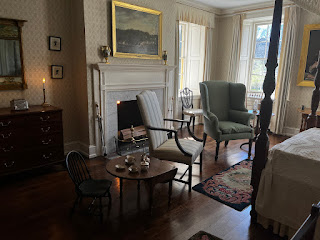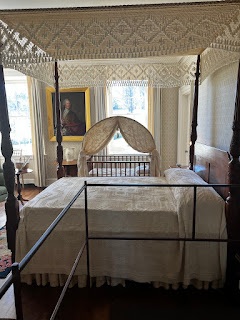Nestled along the Brandwine Creek, close to Wilmington, stands a fascinating outdoor museum devoted to preserving the legacy of Eleutheria du Pont, the French emigrant who left his native land to settle in this scenic area.
My friend, Kathy, had mentioned the Hagley Museum to me as a place of interest that she thought that Marty and I would enjoy discovering. And, she was absolutely right!
I was somewhat familiar with Henry duPont, but had never delved into his history. Here at Hagley Museum, we step back in time to 1799, when his grandfather, Pierre, and his parents, Eleutheria and Sophie braved the seas to come to America, where they chose to settle along the Brandywine Creek.
The location along the flowing water made it an ideal setting to set up his black powder works. Eleutheria had studied under Antoine Laviosier in France, and soon realized that the formula used in the American factories paled in comparison to the one of which Eluetheria had studied in his native country. He had perfected the combination of Potassium nitrate/sulfer/charcoal ratio to result in the finest black powder that was distributed under the name of the DuPont Company, and this location was named the Eleutherian Mills.
The 235 acres have a lot to offer the visitor, but I'm still in recovery with my knee injury, so we opted to explore the highlights, and took advantage of the complimentary shuttle to get to and from the family home on the hill.
But first, we entered the museum which at present time is devoted to the history of patents. This particular building, which also stands along the water, was once a cotton mill, and on display is a model of just how it would have looked back in 1810.
The layout was quite familiar, as we have toured similar factories for wool and linen on various trips to Scotland. But it was interesting to see it presented in this manner in miniature.
Around the corner was the entrance to the patent exhibit.
There was a wealth of information to see, but we were limited in time as we had been scheduled for the house tour that was beginning at the top of the hour, so I quickly walked through the rooms that I found particularly interesting.
Here you see the patent for an improved electric vapor chair, by Mary A Hayward.
It was designed to apply vapor for opening pores of the skin for medical purposes.
Below is the patent for a better sewing machine needle.
As you can see, the museum did an excellent job at making the displays inviting.
Here you see an 1867 patent for a lounge that functioned as one-piece-does-it-all with a bureau, writing desk, folding table, easy chair and night chair all rolled into one.
I think I could use one of those!
There was an interesting section on train patents
and a large display of Ball Mason Jars along with the patent.
But what was really entertaining, were these giant sized Rubics cubes.
How fun is that?
Soon it was time to head to the shuttle, so we hopped on board and enjoyed the ride up to the stables and house where the family had lived.
We were ushered into a building and given a very interesting history of the family before we were shown to the stables to view a brand new display featuring various vehicles that the family had owned over the years.
An 1890 Broughman Carriage, owned by Francis Gurney du Pont who served as Vice President of the Company from 1889-1902.
A 1912 Detroit Electric Car owned by Louisa d-Andelot du Pont Copeland. It ran on battery power.
A 1918 Cadillac that belonged to Irenee du Pont
A 1931 Children's Speedster
And, finally, a 1941 Indian Model 841 Motorcycle that was the personal property of E Paul duPont.
Walking out the back of the stables offered this spectacular view of the front of the house.
It was originally built in 1803, but was renovated in 1929 when the last owners, Louisa and Frank Crowninshield occupied it as their home. Louisa enjoyed collecting unusual items, as did her brother, Henry, who furnished Winterthur. If you are a follower of my blogs, you might recall my writing about that fascinating estate in the past.
Unlike her brother, Louisa did not decorate the rooms according to a time period or theme. She merely placed items where she liked them. I spotted a few unusual pieces that I'd like to share.
There were several lamp shades with this intricate type of cut out. I loved the cozy effect.
The porcelain dogs reminded me of our trips to Scotland where nearly every residence that we toured had set of these on display.
The "train" decanter was entertaining.
Here are busts representing Pierre and his wife
And here you can see the view from the veranda off the back of the house.
On the upper floor, the rooms were decorated more like the Civil War Era.
The rocking house was made by a duPont family member, although I cannot recall who.
And the painting in the distance reminded me of Lafayette. We had been told that he was friends with Pierre and his son, and visited the house on at least one occasion. The bed was original to the family.
There was a nursery right next door.
We were told that this large room was used by Pierre when he stayed in residence.
I particularly liked the color scheme.
And there was an unusual sewing table among its collections, as well as an exceptionally large armoire. These items, along with the bedroom items, were original family heirlooms.
Upon exiting the side of the house, an inscribed stone gives the dates and the initials of the duPont family who were in residence.
Louisa passed in 1958, without any children, and the house was somewhat in disrepair when it was rescued and restored to what one sees today.
Nearby stands the working office for the Mills. The items are not original, but are period pieces to fit in with the timeline.
A safe in the wall secured paperwork, since the company had to safeguard against explosions due to the nature of the black powder's ability to combust.
And, finally, this typewrite is certainly a gem. No "asdf jjkl;" on this little machine.
Walking out of the office building, we had one last peek of the house, which looked quite spectacular standing against a bright blue sky. What a brilliant day for a visit!
Of course, Marty needed a selfie!
Our tour lasted well over an hour, and we headed to the shuttle to take us away from the house and towards the Powder Mills. On the way, we passed the ruins of the Italian Garden that Louisa had spent 10 years perfecting.
The preservation team hopes to restore the gardens somewhat to their original beauty, as they acquire the funds to move forward.
The shuttle dropped us off near the machine shop where we watched a live demonstration using simply water power and turbines to operate heavy power equipment. It was quite fascinating to see!
It was time to head to down to the powder mills for the next live demonstration.
The powder mills stand in a row, separated by some distance for protection in the event of a possible explosion. They are three sided, with the open side facing the river. The idea was for any possible explosion to be released via the open side towards the water, thereby, hopefully eliminating multiple building casualties.
We watched a live, small, demonstration of the combustion ability of the black powder, which let out quite a loud bang. We learned that buyers demanded a demonstration before purchasing, and during the Civil war, each batch was tested to be certain that a canon ball could travel a certain distance from its release.
Another interesting piece of information pertaining to the family was that the powder was only sold to the northern states for use during the Civil War. The company would not capitalize on selling to both sides.
With the demonstration complete, we began the walk to the car park at the entrance. The scenery along the way certainly didn't disappoint.
It was a bit chilly, but the bright sunshine made up for the cold, and, as you can see, it was a brilliant day for exploring.
Before leaving for home, we ventured down the road a bit where we stopped to check out this magnificent view. I have no idea what the white building is, but it certainly did make a nice background on this beautiful day.
And that's a wrap for this gallivanting adventure! I hope you enjoyed tagging along.
Until next time....




















































No comments:
Post a Comment